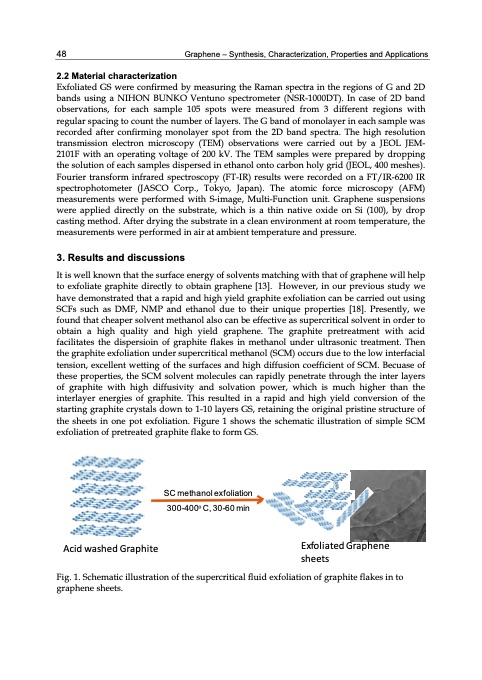PDF Publication Title:
Text from PDF Page: 058
48 Graphene – Synthesis, Characterization, Properties and Applications 2.2 Material characterization Exfoliated GS were confirmed by measuring the Raman spectra in the regions of G and 2D bands using a NIHON BUNKO Ventuno spectrometer (NSR-1000DT). In case of 2D band observations, for each sample 105 spots were measured from 3 different regions with regular spacing to count the number of layers. The G band of monolayer in each sample was recorded after confirming monolayer spot from the 2D band spectra. The high resolution transmission electron microscopy (TEM) observations were carried out by a JEOL JEM- 2101F with an operating voltage of 200 kV. The TEM samples were prepared by dropping the solution of each samples dispersed in ethanol onto carbon holy grid (JEOL, 400 meshes). Fourier transform infrared spectroscopy (FT-IR) results were recorded on a FT/IR-6200 IR spectrophotometer (JASCO Corp., Tokyo, Japan). The atomic force microscopy (AFM) measurements were performed with S-image, Multi-Function unit. Graphene suspensions were applied directly on the substrate, which is a thin native oxide on Si (100), by drop casting method. After drying the substrate in a clean environment at room temperature, the measurements were performed in air at ambient temperature and pressure. 3. Results and discussions It is well known that the surface energy of solvents matching with that of graphene will help to exfoliate graphite directly to obtain graphene [13]. However, in our previous study we have demonstrated that a rapid and high yield graphite exfoliation can be carried out using SCFs such as DMF, NMP and ethanol due to their unique properties [18]. Presently, we found that cheaper solvent methanol also can be effective as supercritical solvent in order to obtain a high quality and high yield graphene. The graphite pretreatment with acid facilitates the dispersioin of graphite flakes in methanol under ultrasonic treatment. Then the graphite exfoliation under supercritical methanol (SCM) occurs due to the low interfacial tension, excellent wetting of the surfaces and high diffusion coefficient of SCM. Becuase of these properties, the SCM solvent molecules can rapidly penetrate through the inter layers of graphite with high diffusivity and solvation power, which is much higher than the interlayer energies of graphite. This resulted in a rapid and high yield conversion of the starting graphite crystals down to 1-10 layers GS, retaining the original pristine structure of the sheets in one pot exfoliation. Figure 1 shows the schematic illustration of simple SCM exfoliation of pretreated graphite flake to form GS. SC methanol exfoliation 300-400o C, 30-60 min Acid washed Graphite Exfoliated Graphene sheets Fig. 1. Schematic illustration of the supercritical fluid exfoliation of graphite flakes in to graphene sheets.PDF Image | GRAPHENE SYNTHESIS CHARACTERIZATION PROPERTIES

PDF Search Title:
GRAPHENE SYNTHESIS CHARACTERIZATION PROPERTIESOriginal File Name Searched:
Graphene-Synthesis.pdfDIY PDF Search: Google It | Yahoo | Bing
Salgenx Redox Flow Battery Technology: Power up your energy storage game with Salgenx Salt Water Battery. With its advanced technology, the flow battery provides reliable, scalable, and sustainable energy storage for utility-scale projects. Upgrade to a Salgenx flow battery today and take control of your energy future.
CONTACT TEL: 608-238-6001 Email: greg@infinityturbine.com (Standard Web Page)